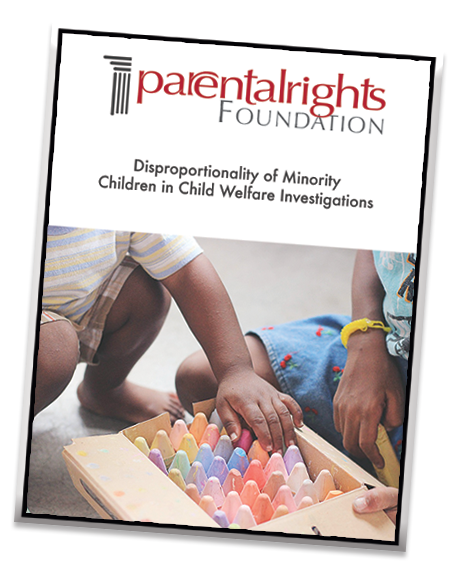New Report Highlights Disproportionality in Child Welfare
April 25, 2018
The Parental Rights Foundation has released a new report on disproportionality in the child welfare system.
The report highlights data from 2016 (the most recent available) showing that nationally the rate of African American children in cases “substantiated” for abuse or neglect is 1.51 times their rate in the general population. (“Substantiated” here is not the same as a verdict of “guilty” in a criminal court; “substantiated” simply means the investigator or department has concluded that, in their opinion, abuse or neglect is more likely to have happened than not.)
Experts on both sides have debated for decades whether and how much this disproportionality stems from racial bias in the system, a sensitive question our report does not address. We focus instead on displaying the degree of disproportionality currently taking place on a state-by-state basis.
And the performance of the different states varies widely. Alabama evidences virtually no disproportionality while, on the other end of the spectrum, a number of states show disproportionality across the board, affecting African Americans, Hispanics, Native Americans, Pacific Islanders/Native Hawaiians, and even those identified as Multiple Race. Many other states show disproportionality affecting one or two of those groupings. And, surprisingly, one southern state even shows disproportionality exclusively against whites.
It is our hope this report will foster new discussions on the importance of parental rights to prevent unfair treatment in child welfare cases.
 The stronger the legal respect accorded to parental rights, the less room exists in the system for a judge, lawyer, or caseworker to exercise their own personal bias and prejudices. In a system where the rights of the parents are paramount (unless there is proof of abuse or neglect), there is simply no room for a white mother, an Asian mother, and an African American mother to be treated differently than each other; they would each be treated with the respect due them as a parent.
The stronger the legal respect accorded to parental rights, the less room exists in the system for a judge, lawyer, or caseworker to exercise their own personal bias and prejudices. In a system where the rights of the parents are paramount (unless there is proof of abuse or neglect), there is simply no room for a white mother, an Asian mother, and an African American mother to be treated differently than each other; they would each be treated with the respect due them as a parent.
The report is available now, and includes a printable pull-out sheet for each state, D.C., and the national total. So share the data with your friends and encourage them to support parental rights for all of us—including racial minority families.
And if you are able to support the ongoing work of the Foundation, we would welcome your donation. Our efforts are entirely supported by partners just like you, so every dollar makes a difference!
Thank you for standing with us and making this project possible. And thank you for helping us spread the word: we must protect the rights of all loving parents, regardless of creed, class, or ethnicity.
Sincerely,

Michael Ramey
Director of Communications & Research
Nationwide Disproportionality Numbers
The following graph is based on 2016 data from the Children’s Bureau’s Child Maltreatment 2016 report. An index number below 1.00 indicates an under-representation of that ethnicity/race in the “maltreatment” child population, while a number above 1.00 indicates an over-representation.

1.51
In 2016, African American children were “substantiated for maltreatment” at a rate 1.51 times more than their proportions in the U.S. child population.
1.23
In 2016, Mixed (2 or more ethnicities/races) children were “substantiated for maltreatment” at a rate 1.23 times more than their proportions in the U.S. child population.
1.59
In 2016, Native American children were “substantiated for maltreatment” at a rate 1.59 times more than their proportions in the U.S. child population.
